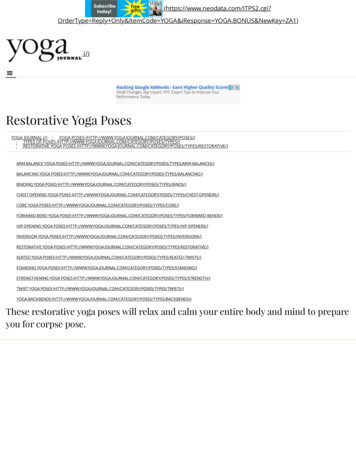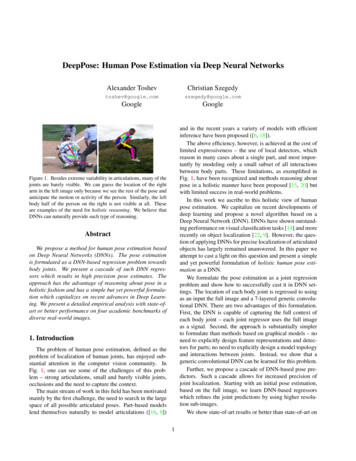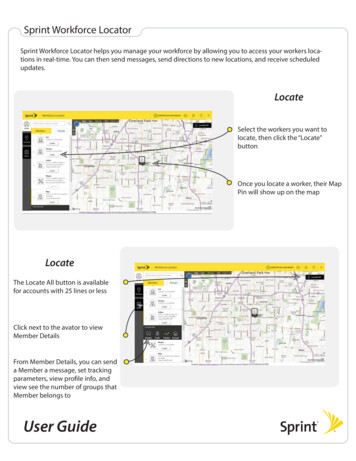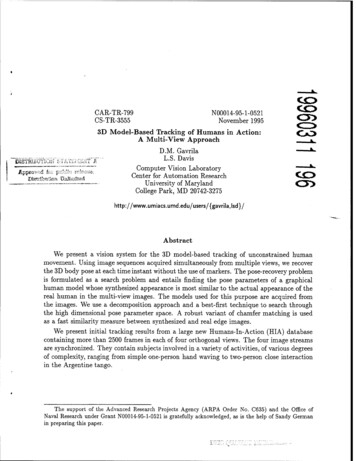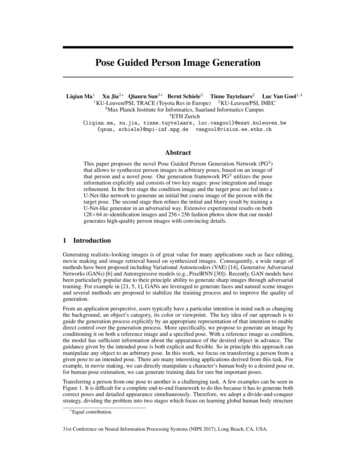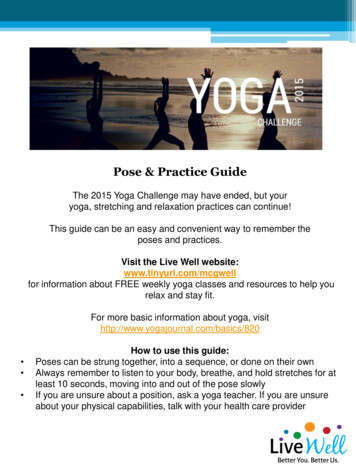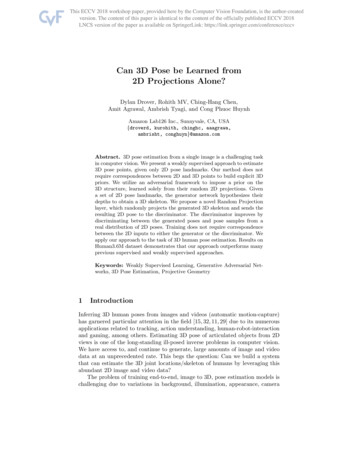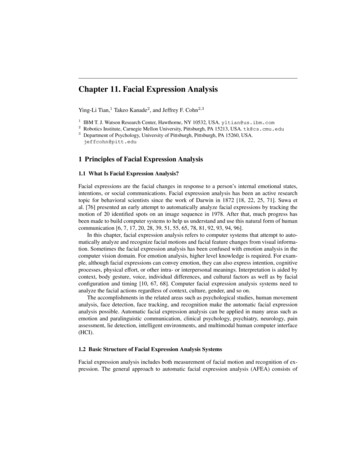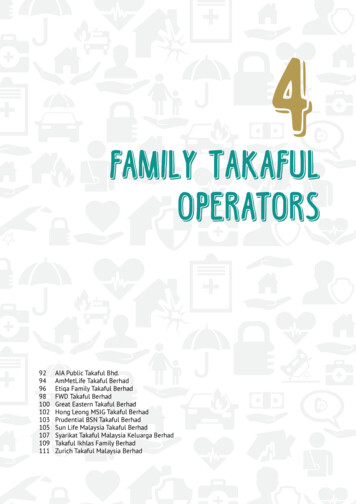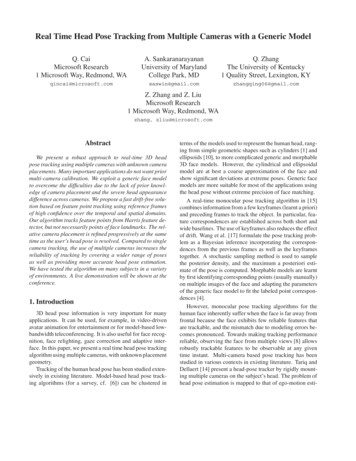
Transcription
Real Time Head Pose Tracking from Multiple Cameras with a Generic ModelQ. CaiMicrosoft Research1 Microsoft Way, Redmond, WAA. SankaranarayananUniversity of MarylandCollege Park, MDQ. ZhangThe University of Kentucky1 Quality Street, Lexington, gmail.comZ. Zhang and Z. LiuMicrosoft Research1 Microsoft Way, Redmond, WAzhang, zliu@microsoft.comAbstractWe present a robust approach to real-time 3D headpose tracking using multiple cameras with unknown cameraplacements. Many important applications do not want priormulti-camera calibration. We exploit a generic face modelto overcome the difficulties due to the lack of prior knowledge of camera placement and the severe head appearancedifference across cameras. We propose a fast drift-free solution based on feature point tracking using reference framesof high confidence over the temporal and spatial domains.Our algorithm tracks feature points from Harris feature detector, but not necessarily points of face landmarks. The relative camera placement is refined progressively at the sametime as the user’s head pose is resolved. Compared to singlecamera tracking, the use of multiple cameras increases thereliability of tracking by covering a wider range of posesas well as providing more accurate head pose estimation.We have tested the algorithm on many subjects in a varietyof environments. A live demonstration will be shown at theconference.1. Introduction3D head pose information is very important for manyapplications. It can be used, for example, in video-drivenavatar animation for entertainment or for model-based lowbandwidth teleconferencing. It is also useful for face recognition, face relighting, gaze correction and adaptive interface. In this paper, we present a real time head pose trackingalgorithm using multiple cameras, with unknown placementgeometry.Tracking of the human head pose has been studied extensively in existing literature. Model-based head pose tracking algorithms (for a survey, cf. [6]) can be clustered interms of the models used to represent the human head, ranging from simple geometric shapes such as cylinders [1] andellipsoids [10], to more complicated generic and morphable3D face models. However, the cylindrical and ellipsoidalmodel are at best a coarse approximation of the face andshow significant deviations at extreme poses. Generic facemodels are more suitable for most of the applications usingthe head pose without extreme precision of face matching.A real-time monocular pose tracking algorithm in [15]combines information from a few keyframes (learnt a priori)and preceding frames to track the object. In particular, feature correspondences are established across both short andwide baselines. The use of keyframes also reduces the effectof drift. Wang et al. [17] formulate the pose tracking problem as a Bayesian inference incorporating the correspondences from the previous frames as well as the keyframestogether. A stochastic sampling method is used to samplethe posterior density, and the maximum a posteriori estimate of the pose is computed. Morphable models are learntby first identifying corresponding points (usually manually)on multiple images of the face and adapting the parametersof the generic face model to fit the labeled point correspondences [4].However, monocular pose tracking algorithms for thehuman face inherently suffer when the face is far away fromfrontal because the face exhibits few reliable features thatare trackable, and the mismatch due to modeling errors becomes pronounced. Towards making tracking performancereliable, observing the face from multiple views [8] allowsrobustly trackable features to be observable at any giventime instant. Multi-camera based pose tracking has beenstudied in various contexts in existing literature. Tariq andDellaert [14] present a head-pose tracker by rigidly mounting multiple cameras on the subject’s head. The problem ofhead pose estimation is mapped to that of ego-motion esti-
mation. We avoid such an approach that requires mountingdevices on the subject because it is usually not preferred.Ruddarraju et al. [12] propose a head pose tracking algorithm using multiple calibrated (both external and internalparameters) cameras. Their approach relies on tracking facelandmarks such as eye and mouth corners at each cameraand triangulating their features. The robustness of this algorithm is limited due to the modeling of the face as a planeas well as the use of a small set of features.Ba and Odobez [2] quantize the orientation of the headand obtain multiple exemplars of the face. A particle filteris used to track over the state space of the location of thehead and the discretized pose. Voit and Stiefelhagen [16]use neural networks to obtain the pose at each camera froma template of the face, and use a Bayesian filter to fuse theindividual estimates. Ng and Gong [11] use SVM to modelchanges on facial images with pose and use multi-view inputs to detect and estimate the head pose. In general, methods performing a discretization of the pose space are moresuitable in low resolution imagery conditions in which 3Dmodel fails because there are no face landmarks that canbe reliably matched. Meanwhile, machine learning basedapproaches for pose estimation require a large amount oftraining data, which inherently discretizes the pose spaceand thus limits the accuracy of the pose estimates.In this paper, we present a multi-camera based real-timepose tracking system without any prior knowledge of thecamera placements. This is extremely useful for many applications wherein usability and ease-of-use often dictatethat the system uses minimal prior calibration. We believethe work described in this paper is one of the first on multiview head pose estimation using a generic face model withthe following properties: it does not require prior calibration of relative camerageometry; it is not required, although beneficial when possible, toobtain explicit correspondences across cameras; it tracks feature points which are not just restricted toface landmarks.relative geometries Pij (i, j 1, . . . , N ; i j), we areinterested in developing a robust framework for real timetracking on the common head pose of a subject in worldcoordinate at time t, i.e., Ptw , from the image sequence Iticaptured by camera i using a 3D generic face model. Figure1 shows the pose relationship between multiple cameras, thehead model and world coordinate system, where Pti is thehead pose at time t viewed from camera i, Pwi is the transformation from world to camera i, i.e. Pti Pwi Ptw . Oneof the cameras c is chosen as the world reference, where ccould change over time. Therefore Pti Pci Ptc . Our posetracking problem becomes finding Ptc and Pci .2.1. Single Camera TrackingSpatial Consistency: We start with single camera tracking by exploring the 2D-3D spatial consistency of featurepoints from camera i. We need to estimate Pti given inputimages Iti and feature points k 1, . . . , K from the headmodel. From 2D-3D correspondences under the perspectiveprojection, Pti is estimated by minimizingei (t) K ρ(uti,k φ(Pti Uk ))(1)k 1where φ(.) is the perspective projection of a 3D point fromthe model in homogeneous coordinate Uk to its 2D correspondence uti,k and ρ(.) is an M-estimator chosen to alleviate gross noise interference. We use the POSIT iterativealgorithm [3] as a pre-processing step to obtain the initialpose estimation at time t. Note we only apply a global scaling in X and Y to the 3D points in a generic face model toobtain an approximate personalized model at this moment.In the future, different scaling could be applied to variousparts of the head model and make the model more accurateto a particular subject.Temporal Smoothing: We apply an aging factor α (0 α 1) up to preceding τ frames to smooth pose estimationThe estimation of the relative camera geometry along withthat of the head pose is done by aggregating the information from all the cameras, and is refined over time throughoptimization. In the remainder of the paper, we formulatethe problem in section 2, describe our tracking frameworkin detail in section 3, then present experimental results insection 4 and conclusion in the end.2. Problem FormulationAssume the position of an object is represented by rotationR and translation t, described by matrix P R t, Given N multiple static cameras with unknown0 1Figure 1. The relationship of poses between the model, the world,and local camera coordinate system.
Pci is the transform from the reference camera to the current camera. The only difference is that ΔPtri changes overtime and Pci addresses the static spatial transform sincecameras are fixed most of the time. In the next section,we will generalize (4) within a Bayesian framework withcertain constraints on Pci .2.3. Bayesian FrameworkFigure 2. Robustness of a tracking algorithm using referenceframes (highlighted in red between t 1, . . . , 0, the current frameis highlighted in blue rectangle) temporally and spatially acrosscameras.temporally, thus the above minimization becomeseti τ 1 αn ei (t n)(2)n 0where τ is set to 3 in our implementation.Reference Frames: The above two constraints cannot prevent tracking from drifting caused by error propagation. Atypical approach is to use reference frames from differenttime instants with a variety of poses. In a multi-cameratracking system described later, we can extend the referenceframes across cameras. Figure 2 shows our generic framework of using reference images for tracking temporally andspatially. Thus we generalize Eqs. (1) and (2) into ωr etr ωrρ(uti,k φ(ΔPtri Ptr Uk )) (3)rrkP (Xt Xt , Yt , It ) P (Xt Xt , It )P (Xt Yt , It ) (5)Assuming each P (.) is a Gaussian distribution and each feature point matching is independent, we derive the following equation for 2D-3D correspondences from the referencecamera c using the reference frame r tomax P (Xt Ztr , It ) tt(utc,k ûtc,r,k )T Σ 1 minc,r,k (uc,k ûc,r,k )k(6)where r represents a reference frame which could be eithera preceding frame up to time t τ or a keyframe, ωr is theweight for the reference frame based on timing window ortracking confidence, and ΔPtri is the pose difference fromthe reference frame to the current one.2.2. Multiple Camera TrackingAs it is not guaranteed that a single camera will be able totrack the face all the time, we extend the above formulationto multi-cameras, and the summarization of ei (t) in Eq. (1)becomesKNK ρ(utc,k φ(Ptc Uk )) ρ(uti,k φ(Pci Ptc Uk ))k 1We consider head poses at one time instant as a statein a dynamic system. Let Xt denote the poses to estimatefrom all the cameras, i.e., Xt {Pti i 1, . . . , N }. LetXt {Xt n n 1, . . . , τ } represent the poses of theprevious frames, and Yt be the poses of keyframes up totime t. The observation input to the system is the imagesequences from the cameras, denoted by It . Extending theBayesian framework for single-camera pose tracking [17],we conduct multi-camera pose tracking by maximizing theposterior probability P (Xt Xt , Yt , It ). Since keyframesare retrieved through a re-detection process independentlyfrom the main tracking thread, we further simplify the problem toi 1,i c k 1(4)with the addition of camera index c and i, where c servesas the reference. The first term is for the reference camera,and the second term is for all other cameras.Comparing the second term in Eq. (4) to Eq. (3), we notice that they are essentially similar in that ΔPtri is the difference from the reference frame to the current frame, andwhere Ztr denotes the pose of a generic reference frame attime t, Σc,r,k is the covariance matrix for feature estimation at point k with reference frame r from camera c, andûtc,r,k φ(ΔPtrc Ptr Uk ) as defined similarly in Eq. (3).This essentially addresses the first term of Eq. (4). The second term follows the similar fashion except that the meanbecomes ûti,c,k φ(Pci Ptc Uk ) for camera i and i c.Meanwhile, we also estimate the relative geometry Pijbetween camera i and j for the benefits of leveraging tracking from different cameras. Although we could use Pij to obtain the relative pose at each time instant, thisPj P 1icould result in unwanted divergence of the invariant Pij .Recall that the cameras remain fixed, we add a smoothness2oldterm Pij Poldij M to Eq. (6), where Pij is the estimatefrom the last instance or the initial guess, and · M denotesthe Mahalanobis distance given by2old T 1old Pij Poldij M (Pij Pij ) Λij (Pij Pij ). (7)where the covariance matrix of Λij controls the adaptationof relative geometry between camera i and j learnt during
optimization. In the end, our total cost for minimization isto combine (4), (6) and (7) with associate weights based onaging factor for previous frames or robustness of the featurematching [19]. ttωr(utc,k ûtc,r,k )T Σ 1et c,r,k (uc,k ûc,r,k )r k ωii,i c tt(uti,k ûti,c,k )T Σ 1i,c,k (ui,k ûi,c,k )k2ωij Pij Poldij M(8)i,j,i j3. Tracking AlgorithmThe main steps of the tracking algorithm is highlightedin this section. Given all the reference frames their associated poses, we select features on the face from the Harrisdetector for tracking from each camera. The KLT algorithm[9] is used to track the features onto the frame at time t.This provides a set of 2D-3D correspondences at each viewtemporally. To make the algorithm less prone to error drift,we retain keyframes accumulated over time for additionalmatches. Both key and previously tracked frames serve asreference for establishing 2D-3D correspondences. Finally,the smoothness constraints for camera geometry is added tothe cost function (8) for optimization.3.1. Initialization and Feature Point MatchingAssume that we know the intrinsic parameters of eachcamera by calibration or supplied from the manufacture.The assumption that the intrinsic parameters do not changeover time is reasonable since there is not much need of PTZcameras for a user sitting in front of the desktop. Tracking from each camera starts with face detection [18] whichidentifies a face rectangle. Then we run 2D mesh alignment[7] to get 2D feature points for initial tracking. Basically,the 3D model is oriented and projected to the individualcamera coordinate in the face region so that we obtain aninitial guess of the camera geometry relative to world coordinate. At each camera, we select point features over theface region based on the KLT selection criterion [13] andback-project these points onto the mesh model to obtain the3D point locations on the model denoted as Urk for camerar at point k. Moving on to the next time instant, we usethe KLT feature point tracking algorithm [9] to track the selected 2D features and obtain the features on the new framesutr,k . Using the Perspective-n-Point (PnP) formulation, arigid pose is determined by minimizing the sum of projection errors given multiple 2D-3D corresponding points. Theuse of POSIT algorithm [3] allows us for a quick coarsepose estimation and inlier verification to achieve real-timeprocessing. Most of the above procedures are depicted inFigure 3. Tracking initialization and key frame insertion.Figure 3. The advantage of the above algorithm is that itis extremely fast, allowing for real time solutions even inthe multi-camera scenario. However, feature point trackersare susceptible to drift. If the error is uncorrected, it leadsto the divergence of the tracking algorithm as the 2D-3Dcorrespondence is no longer valid. In order to make the algorithm robust to drift, we expand the selection of referencetracking to include keyframes.3.2. Keyframe Addition as ReferenceOur keyframe comprises of an image and the pose ofthe head observed in the image. This provides an absolutereference to restrict drift. Over the time of tracking, wemaintain a set of keyframes extracted from an independentinitialization thread similar to the process in Figure 3. Wethen proceed to obtain 2D-3D correspondences between thecurrent image and the keyframe. Keyframes are consideredas one type of reference frames which are always availablefor matching with the current frame, as emphasized in (3).Since the pose of the reference frame could differ significantly from the query pose (i.e., the latest pose), we warpthe face from its pose in the reference frame to that of thequery. This is done by aligning the feature points in 2D image from reference pose to the 3D face model, and renderingit onto the image based on the query pose. As a result, thewarped face image and head pose from the reference frameare expected to be in a reasonable proximity of the currentimage and pose. Referencing on both keyframes and previous frames corrects drift during tracking and allow us to apply the same simple feature point correspondence betweenthe 3D model and its 2D projection. Thus the POSIT algorithm can be applied again for fast pose estimation.Ideally, the keyframe storage should contain a varietyof poses viewed from all cameras with high confidence oftracking, along with its corresponding images. This pool iscommon to all cameras, and shared across views. However,
using reference frames across camera views can be affectedadversely by illumination effects. It is important to keepthis in mind, and use suitable illumination normalization inmatching feature points, or select appropriate keyframes under similar illumination condition. Also, a frame is addedas a new keyframe only if the pose is sufficiently far awayfrom all existing ones to ensure the diversity of key posesto achieve better tracking at various poses. In video conferencing applications, the poses close to frontal form animportant type of keyframes [15] as a user most likely talksdirectly to the cameras. To handle such preferred poses, weadd the initializing frame for each camera as a keyframewhen the face is detected and aligned.3.3. Joint Pose Estimation via OptimizationPose estimation includes both the common pose of thehead Pt in world coordinate and the relative poses Pij between camera i and j (i, j 1, . . . , N ). They are estimated together by minimizing (8). In our implementation,the Levenburg-Marquardt (LM) technique is used. Besidesthe pose estimates, their uncertainty (covariance matrix) isalso computed. More technical details are provided in thefollowing sections.Pose From Each Camera: For each camera j wheretracking is successful, we use the 2D-3D correspondence(utj,k , Uk ) between the current image and all possible reference frames, apply the RANSAC robust estimation technique with the POSIT algorithm to discard outliers, andget an approximate pose estimation Ptj with the remaininggood correspondences. Among all cameras being tracked,we choose the one with the highest matching fidelity, whichis usually the one closer to the frontal pose, as a referencecamera c. Then we use Ptj Pcj Ptc to estimate poses fromall other cameras.Relative Geometry: As described above, relative geometryPij between camera i and j is needed during the joint poseestimation. The initial estimate of Pij could be either theestimation at the previous instance if tracked, or calculatedas Pj P 1if i ri(9)Pij Pcj P 1if i rci Pcj PicIf Pij is never initialized, its corresponding covariance matrix is set to a very large value, indicating poor knowledgeof the relative geometry between camera i and j. Sincethe cameras are static, the incorporation of the Mahalanobis2distance Pij Poldij M from Eq. (7), imposes a constraintthat the relative camera geometry Pij at time t is expectednot to be too different from the previous estimate Poldij ifmulti-camera tracking is getting accurate.Dynamic Switching of the Reference Camera: Note thatwe cannot pre-select a camera as reference because thereis no guarantee that the face will be viewed clearly fromthis particular camera during the course of tracking. Theadvantage of using multiple cameras is that at least one ofthe cameras in the system will most likely have a good viewof the face so that the pose estimation for other views couldleverage from that. Thus, we usually select a camera closeto frontal view of the face and allow dynamic switching ofthe reference camera for better tracking result.LM Optimization: At the end, let the reference camera bec, and we group all the parameters to be determined as theunion of Ptc and Pcj (j 1, . . . , N ; j c) and apply theLevenburg-Marquardt (LM) method to minimize the overallcost in Eq. (8). Once Ptc and Pcj are solved, we can easilyestimate the pose for a camera which has lost tracking dueto occlusion or poor angle of the face using the pose fromreference camera.Due to dynamic switching of the reference camera, thecovariance matrix Λij is directly updated during optimization only if camera i or j is selected as reference. If weneed to update Λij when neither camera i or j is selected asa reference camera, we use the first order Taylor expansionand compute it with the following formulaΛij (Pcj Pic ) (Pcj Pic ) TΛic [] Pic Pic (Pcj Pic ) (Pcj Pic ) T Λcj [] Pcj Pcj(10)where partial derivative (.) is approximated using the difference between the estimated poses at time t and t 1.3.4. Tracking ProcessThe overall tracking process is illustrated in pesudo codein the algorithm shown in the next page.4. Experimental ResultsWe implemented our tracking framework in a systemwith a dual core 3 GHz processor PC and multiple LogitechVX9000 web-cameras with image size of 320x240. Thegeneric face model we use for face alignment is based on[5]’s face model with 83 landmarks. Our head pose trackingsystem runs at an average frame rate of 15 fps when threecameras are involved. We demonstrated our tracking algorithm with tens of subjects in various environments such asindoor offices, conference rooms and busy demo floors forbig events with satisfying results, i.e., subjects saw the 3Dhead model points overlaid on the video sequence with facelandmarks closely matched. Due to space constraints, weonly show some examples of tracking results in Figure 4, 5and 6.To compare the tracking result to the ground truth, wecaptured a one-minute long sequence from three camerason a subject wearing a hexagonal crown (see Figure 5) at 30frames per second. The ground truth is estimated by calibration at each view independently. The tracking results ob-
Algorithm: Multi-Camera 3D Head Pose TrackingInput: images at time t, It , the previous frames Xt n(n 1, . . . , τ ), and the keyframe set Yt fromall camerasOutput: Refined pose Pt1. Select reference frame Pt 1from each camera.r2. Initialize the relative pose Pci to Poldci . If it is neverinitialized, use Eq. (9) with a large uncertainty.foreach camera i doforeach frame Ztr Xt n Yt do3. Find feature matches (û, u) between imageIit and the image Irt and back-project features(u) in Irt onto the 3D model to get (U).4. Discard outliers by applying RANSAC.end5. Compute an approximate pose estimate byapplying POSIT to the inlier feature subset.end6. Select a new reference camera c if necessary.7. Minimizing the cost function (8) using LMalgorithm to optimize the pose from the referencecamera Ptc and relative poses Pci .8. Update the common pose and relative poses.(a) Frame 0001(b) Frame 0888Figure 5. Multi-camera tracking results with three cameras. Thehexagonal cap was used to obtain ground truth for the head poseas well as the camera placement.between cameras using the same data as in Figure 6. Sincethe three cameras are static, we should expect flat lines forboth the rotation and translation in 3D. We notice that the1.510.5Euler Anglestained from the multi-camera tracker was matched againstthe ground truth allowing for a scaled Euclidean transformation between the two sets of estimates. Figure 6 showsthe tracking results overlaid on ground truth estimates forboth the rotation (in terms of three Euler angles: roll in red, pitch in green and yaw in blue) and translation (x, y and zcomponents in red, green, and blue, respectively). Note thatthe mismatch between ground truth and the tracker occursonly at extreme translations where even the ground truthmight be incorrect.Figure 7 shows the comparison results of estimated camera relative pose and the ground truth of essential matrices0 0.5 1 1.5 205001000Frame Number15002000150020001210(a) Cam 0Distance in 3D Space86420 2 40(b) Cam 1Figure 4. A sub-sampled tracking sequence from two cameraswhich leverage each other during occlusion.5001000Frame NumberFigure 6. Comparison of head pose from multi-camera pose tracking (shown in dotted line) against manually labeled ground truth(shown in circles). They coincide well as the dotted lines mostlypass through the circles. The results were obtained over the videoshowed in Figure 5.
Figure 8. A comparison of single-camera and multi-camera tracking in a severe occlusion case. The Red, Green and Blue thicklines represent the x, y and z components of the head translationestimated by the single-camera tracking, while those thin lines, bythe multi-camera tracking.Figure 7. Comparison of relative geometry between camera 1 and2 from multi-camera pose tracking (shown in dotted line) againstmanually labeled ground truth (shown in circles).estimated rotation angles are even better than the groundtruth in certain instances when there is clearly outlier during calibration.To compare with the monocular pose tracking, we testedanother half minute long video with occlusions capturedfrom three cameras at 30 fps. Figure 8 shows a time instant with severe occlusions from two of the three views.In this case, single camera tracking fails in the two views,but multi-camera tracking is still able to track from all threeviews by leveraging the reference camera with little occlusion. The plot in the figure shows the estimated 3D translation of the head with single-camera (thicker line) and multicamera tracking (thin line). The flat thicker line showsthe instances when single camera tracking fails, while themulti-camera tracking still succeeds.Further comparison on tracking between a single cameraand two-camera system is shown in Figure 9 using anotherhalf minute long video sequence shown in Figure 4, wherethe interframe differences are computed for rotation andtranslation. For illustration purpose, we use a pre-selectedvalue π/2 for rotation and 10.0 for translation when lossFigure 9. Performance Comparison on tracking using one cameraand two cameras.of tracking happens. Note that the single camera trackingfailed quite a number of times.
Comparison of tracking performance between single andmulti-camera are data dependent. We could choose a sequence of data with frequent occlusions to favor the multicamera tracking. On the other hand, if cameras are placedclose to each other and faces are mostly frontal, we shall notsee much difference in performance between the two. Thefollowing table shows the performance evaluation of usinga single camera, two cameras and three cameras, comparedto a three camera tracking system with pre-calibrated camera geometry, using the image sequence described in Figure5. We intentionally avoid occlusion in the video for a faircomparison. We tested our tracking algorithm by assumingthere are one, two or all three cameras in the system respectively. The rotation error is measured in angular degrees,and translation is in millimeters. As we expected, the average re-projection decreases with the increase of the numberof cameras. We also notice that the tracking performanceis almost equivalent compared to the case where cameraplacements are pre-calibrated (shown in the last row of thetable). We also notice that single camera tracking has largermean rotation error in degree. This is mainly due to loss oftracking for profile poses where we just use the frontal poseas default. On the other hand, multi-camera tracking is ableto estimate a pose most of the time using a reference cameradynamically, resulting in smaller mean errors.# ofCams1233 (calib)MedianAng err5.97545.48784.46714.0827MedianTran err0.41380.34810.34040.3132MeanAng err19.013211.803911.091511.0577MeanTran err0.55040.48850.46340.45405. ConclusionIn this paper, we described a real time head pose tracking framework with multiple cameras and unknown placement parameters. The proposed algorithm achieves realtime tracking requirements as well as the ability to estimateand refine the camera placement parameters. Furthermore,by using generalized reference frames in both temporal andspatial directions, the algorithm remains drift free within alarge pose range. Future work in this regard involves adapting the face model parameters to customize the 3D model tothe individual being tracked. Also of interest is multiple object tracking that could make cross-camera correspondencesmore robust.References[1] G. Aggarwal, A. Veeraraghavan, and R. Chellappa. 3D Facial Pose Tracking in Uncalibrated Videos. Lecture Notes inComputer Science, 3776:515, 2005.[2] S. O. Ba and J.-M. Odobez. Probabilistic head pose trackingevaluation in single and multiple camera setups. In ][16][17][18][19]modal Technologies for Perception of Humans: InternationalEvaluation Workshops CLEAR 2007 and RT 2007, pages276–286. Springer-Verlag, Berlin, Heidelberg, 2008.D. Dementhon and L. Davis. Model-based object pose in25 lines of code. International Journal of Computer Vision,15(1):123–141, 1995.P. Fua. Regularized Bundle-Adjustment to Model Headsfrom Image Sequences without Calibration Data. International Journal of Computer Vision, 38(2):153–171, 2000.F. Jiao, S. Li, H.-Y. Shum, and D. Schuurmans. Face alignment using statistical models and wavelet features. Computer Vision and Pattern Recognition, IEEE Computer Society Conference on, 1:321, 2003.V. Lepetit and P. Fua. Monocular model-based 3d tracking ofrigid objects: A survey. Foundations and Trends in Comput
head and the discretized pose. Voit and Stiefelhagen [16] use neural networks to obtain the pose at each camera from a template of the face, and use a Bayesian filter to fuse the individualestimates. Ng and Gong [11] use SVM to model changes on facial images with pose and use multi-view in-puts to detect and estimate the head pose. In general .
